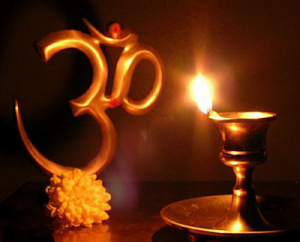Symbols are very important in the evolution of man. People used to think in symbols, as they had no vocabulary to express abstract ideas and qualities. Before the alphabet was invented, there was only picture reading and writing. The ancient Egyptian Book of the Dead is written entirely in picture symbols. Modern psychology has revealed the significance of symbols in relation to the subconscious mind.
There are two minds, the conscious and the subconscious. The subconscious mind stores the memories right back to childhood, along with the racial memories since the dawn of history. It is the seat of deep feelings and emotions and also of telepathy, clairvoyance, hypnotism and other occult powers. The activity of the subconscious mind is seen in dreams. For example, if some feeling of ambition is aroused in the mind, we dream that we are flying in the air. If there is fear in our mind, we dream of demons and frightful animals. Suggestion or repetition of the same idea again and again also influences the subconscious mind. It can be influenced by loud sounds like ringing bells or music. The subconscious mind is hardly influenced by intellectual ideas. It thinks entirely in symbols.
Stages of worship
 Pooja vidhi, the ways, rules and secrets of worship with form, are described in the ancient scriptures. They are scientifically accurate and highly rational. Those who denigrate the worship of images or murtis have not studied the scriptures or associated with devotees or great souls. Sanatana Dharma upholds that various images and symbols are required to prepare the mind for concentration.
Pooja vidhi, the ways, rules and secrets of worship with form, are described in the ancient scriptures. They are scientifically accurate and highly rational. Those who denigrate the worship of images or murtis have not studied the scriptures or associated with devotees or great souls. Sanatana Dharma upholds that various images and symbols are required to prepare the mind for concentration.
There are thousands of images and symbols to select from, and one chooses according to one’s spiritual ideals and convictions. At the same time, the use of an image is not compulsory, and for some advanced sadhakas, yogis or sages, it may not be necessary at all.
A symbol is like the slate used by a child to learn the letters of the alphabet. Those who do not need the symbol have no right to say that it is wrong to use one. In the beginning, there is nothing wrong with superimposing God and His attributes on an image. However, one must think of the antar atma, or inner spirit, that is hidden in the image. Worship of an image is only the beginning of spirituality and certainly not the end. There are different grades of worship, each marking a stage of progress.
The first stage is the performance of ritual worship and pilgrimage to holy places. The next is recitation of mantras and offering of prayers. The third is worship of symbols. The fourth is meditation on the Supreme Self, the Absolute or the attributeless, nirguna-Brahman. The final state is self-realization, or Brahma-sakshatkara.
In this process, the shastras and gurus are like kind mothers. They lead the aspirants step-by-step, until they are established in nirvikalpa samadhi or the superconscious state. For beginners with a gross mind, they prescribe external forms of worship. For the advanced aspirant, endowed with a pure, subtle and sharp intellect, they give lessons on abstract meditation. Aspirants make different attempts to grasp and realize the Infinite or the Absolute, according to the degree of evolution.
Purpose of the symbol
 The image of God is a support for the neophyte, a prop during one’s spiritual childhood. A form or image is necessary in the beginning as an external reminder of God. The worshipper associates the ideas of infinity, omnipotence, omniscience, omnipresence, purity, perfection, freedom, holiness and truth with the chosen form of worship. The material image calls up the mental idea. Steadiness of mind is obtained by the worship of an image. For a beginner concentration or meditation is not possible without a symbol. The mind requires a symbol because it cannot hold a concept of the absolute in the initial stages of practice. To behold God everywhere and to feel His presence every moment is not possible for the ordinary person. The mind cannot be centralized and fixed on the absolute without the help of some external aid.
The image of God is a support for the neophyte, a prop during one’s spiritual childhood. A form or image is necessary in the beginning as an external reminder of God. The worshipper associates the ideas of infinity, omnipotence, omniscience, omnipresence, purity, perfection, freedom, holiness and truth with the chosen form of worship. The material image calls up the mental idea. Steadiness of mind is obtained by the worship of an image. For a beginner concentration or meditation is not possible without a symbol. The mind requires a symbol because it cannot hold a concept of the absolute in the initial stages of practice. To behold God everywhere and to feel His presence every moment is not possible for the ordinary person. The mind cannot be centralized and fixed on the absolute without the help of some external aid.
Therefore, a symbol is indispensable for a beginner. The mind is disciplined by fixing it on a concrete object or symbol. The image or murti of the deity, sun, fire, water, shaligram, lingam, swastika, cross, Om, Tao, circle or triangle are symbols that help the aspirant to attain one-pointedness of mind and purity of heart. As the aspirant advances in meditation, the form melts into the formless, and one becomes absorbed in the formless essence. The worship of form is not contrary to the view of Vedanta. The vedantin has the symbol of Aum to fix the wandering mind. Images of God are considered an aid to the highest vedantic realization.
Symbols may be concrete or subtle. Pictures and drawings are pictorial forms of images. The gross mind needs a concrete symbol as a base, and the subtle mind requires an abstract symbol. The Puranas and the Agamas describe how form is to be worshipped both in the home and temple. Worship of form is not peculiar to any one religion. Every Hindu worships an image of his choice. Christians worship the cross and they have the image of the cross in their mind when they pray. Muslims hold the direction of the Kaaba in their mind when they kneel and pray. Most people throughout the world are worshippers of form. They keep an image in their mind.
Every deity is identified with a separate universal power. For example, the Sun is a divinity, representing the spirit of all sentient and insentient beings. It is given different names like Aditya, Vishnu and Mitra. Indra is described as the god of warfare, who bestows victory. Usha is the deity of the dawn. Maruts are deities of power. Agni symbolizes the light of the Sun on Earth. Agni is worshipped for the purpose of gaining food and nourishment, wealth, cattle, sons, and so on. The mental image is a form, and the difference is not of kind, but of degree. All worshippers, however intellectual they may be, generate a form in the mind and make the mind dwell on that image.
Communion with God
 A symbol is a medium for establishing communion with God. Images are not idle fancies of sculptors, but shinning channels through which the heart of the devotee is attracted to God and flows towards Him. Although the devotee appears to worship an image of God, he is actually feeling the presence of the Lord within that image and pours his devotion upon it.
A symbol is a medium for establishing communion with God. Images are not idle fancies of sculptors, but shinning channels through which the heart of the devotee is attracted to God and flows towards Him. Although the devotee appears to worship an image of God, he is actually feeling the presence of the Lord within that image and pours his devotion upon it.
The ignorance of modern sensual people clouds their vision and prevents them from seeing the divine in the lovely and enchanting images of His forms. The scientific advances of this century ought to convince one of the glories of symbolic worship. Are the singers and orators confined to a small box called a radio or television? The box is a lifeless, mechanical structure, which if thrown, would break into a thousand pieces. But if one knows how to use it, one can hear music and see pictures which are occurring hundreds or thousands of kilometres away through it.
Just as one catches the sound waves of people all over the globe through radio and TV, it is possible to commune with the all-pervading Lord through the medium of an image. The divinity of God is vibrant in every atom of creation. There is not a speck of space where He is not found. Many people say, “God is an all-pervading formless being. How can He be confined to this image?” But are these people really conscious of His omnipresence and do they see Him and Him alone in everything? No. Their ego prevents them from bowing down to the image of God.
The bhakta beholds the Lord in the symbol or image. For him there is no such thing as insentient matter; everything is God or consciousness. His worship of an image is worship of God.
Representation
All images including pictures, drawings, photos, icons and idols are symbolic forms. They represent the cosmic body of the Lord, and the Lord is pleased when His body is worshipped.
A reputed businessman once said, “Swamiji, I have no faith in the worship of images; it is all foolishness.” This man had a photo of his guru in his pocket, and I asked him to take it out and spit on it. He was aghast and replied, “Swamiji, this is a photo of my mentor. I serve him, I have great respect for him, and he has made me a success in life. How can I spit on his picture?” I said, “Look here my friend, you love your master and this paper image reminds you of the respect you have for him. The picture is not the man in person, nor can it eat or move. It is just a piece of paper! You associate his presence with the photo. Is this not worship of an image?”
A person who worships and meditates and is full of knowledge and real devotion, always keeps silent. He alone knows whether or not an image is necessary in the beginning of his search for God. However intellectual one may be one cannot concentrate without the help of a symbol. An intellectual person may say, “I do not like idols; I do not wish to concentrate on a form.” Yet, he cannot concentrate on the formless God either. Therefore, due to his ego, he fails to progress in his worship. The idol is a concrete, physical image or symbol. It is a representation of God, which is an abstract concept. The image in a temple, though it may be made of stone, wood or metal, is precious to a devotee as it bears the mark of his Lord, and represents something that he holds holy and eternal.
The devotee superimposes all the attributes of the Lord on the image, and when his devotion and meditation becomes intense and deep, he does not see the form as a stone image. He beholds it as the Lord, who is pure consciousness. Therefore, the worship of form is very necessary for beginners on the path of spiritual awakening. The idol may remain an idol, but the worship goes to the Lord. The inner love of the devotee finds expression through external forms of worship. The wandering mind is fixed in this form of worship and the aspirant gradually feels the nearness of the Lord. He attains purity of heart and slowly annihilates his egoism. All matter is a manifestation of God.
God is present in everything and everything is an object of worship.
~ From the teachings of Swami Sivananda Saraswati










